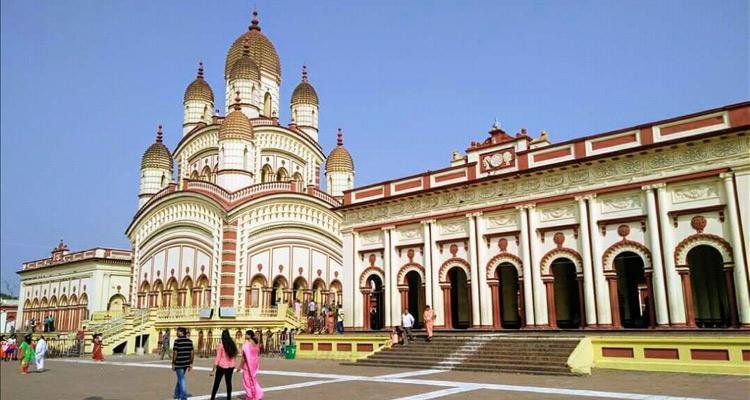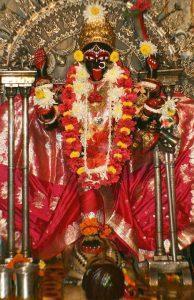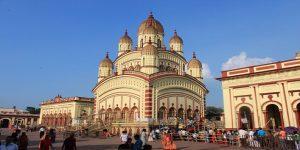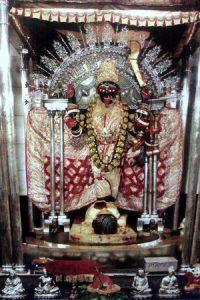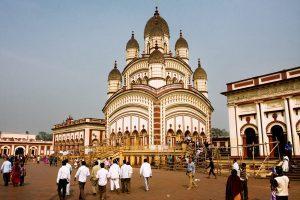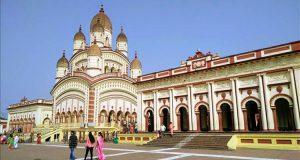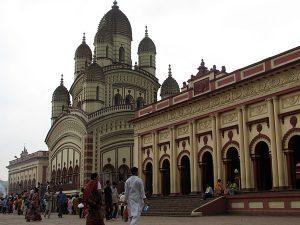Dakshineswar Kali Temple, North 24 Parganas, West Bengal
| Date built: | 1855 |
|---|---|
| Deity: | Bhavatarini kali |
| Architectural style: | Bengal architecture |
| Major festivals | Kali Puja, Snana Yatra, Kalpataru Day |
| Locale: | Kolkata |
| District:: | North 24 Parganas |
| Address: | Dakshineswar, Kolkata, West Bengal 700076 |
| Phone | – |
Dakshineswar Kali Temple is a Hindu temple located in Dakshineswar near Kolkata. Situated on the eastern bank of the Hooghly River, the presiding deity of the temple is Bhavatarini, an aspect of Kali, meaning, ‘She who liberates Her devotees from the ocean of existence i.e. Saṃsāra’.The temple was built in 1855 by Rani Rashmoni, a philanthropist and a devotee of Kali. The temple is famous for its association with Ramakrishna, a mystic of 19th Century Bengal.
The temple compound, apart from the nine-spired main temple, contains a large courtyard surrounding the temple, with rooms along the boundary walls. There are twelve shrines dedicated to Shiva—Kali’s companion—along the riverfront, a temple to Radha-Krishna, a bathing ghat on the river, a shrine dedicated to Rani Rashmoni. ‘Nahabat’, the chamber in the northwestern corner just beyond the last of the Shiva temples, is where Ramakrishna spent a considerable part of his life.
Architecture
Built in the traditional ‘Nava-ratna’ or nine spires style of Bengal architecture, the three-storeyed south-facing temple has nine spires distributed in upper two storeys, and stands on a high platform with a flight of stairs, overall it measures 46 feet (14 m) square and rises over 100 feet (30 m) high.
The garbha griha (sanctum sanctorum) houses an idol of goddess Kali, known as Bhavatarini, standing on the chest of a supine Shiva, and the two idols are placed on a thousand-petaled lotus made of silver.
Close to the main temple are the row of twelve identical Shiva temples built facing the east in the typical aat-chala Bengal architecture, they are built on either side of the ghat on the Hooghly river. To the North east of the Temple Complex is the Vishnu Temple or the Radha Kanta Temple. A flight of steps lead to the columned verandah and into the temple where a silver throne rests with a 21 1⁄2-inch (550 mm) idol of Lord Krishna and a 16-inch (410 mm) idol of Radha.
Legend / Local stories
The Dakshineswar Kali Temple was founded around the middle of the 19th century by Rani Rashmoni.Rani Rashmoni was a Mahishya by caste and was well known for her philanthropic activities. In the year 1847, Rashmoni, prepared to go upon a long pilgrimage to the sacred Hindu city of Kashi to express her devotions to the Divine Mother. Rani was to travel in twenty four boats, carrying relatives, servants and supplies.According to traditional accounts, the night before the pilgrimage began, Rashmoni had a vision of the Divine Mother, in the form of the goddess Kali in a dream and reportedly said There is no need to go to Banaras. Install my statue in a beautiful temple on the banks of the Ganges river and arrange for my worship there. Then I shall manifest myself in the image and accept worship at that place.
Profoundly affected by the dream, Rani immediately looked for and purchased a 20-acred plot in the village of Dakshineswar. The large temple complex was built between 1847 and 1855. The 20-acre (81,000 m2) plot was bought from an Englishman, John Hastie and was then popularly known as Saheban Bagicha,[8] partly old Muslim burial ground shaped like a tortoise, considered befitting for the worship of Shakti according to Tantra traditions, it took eight years and nine hundred thousand rupees to complete the construction, and finally the idol of Goddess Kali was installed on the Snana Yatra day on 31 May 1855, amid festivities at the temple formally known as Sri Sri Jagadishwari Mahakali, with Ramkumar Chhattopadhyay as the head priest; soon his younger brother Gadai or Gadadhar (later known as Ramakrishna) moved in and so did nephew Hriday to assist him.On 31 May 1855 more than 1 lakh Brahmins were invited from different parts of the country to grace the auspicious occasion. The next year, Ramkumar Chattopadhyay died, the position was given to Ramakrishna, along with his wife Sarada Devi, who stayed in the south side of the Nahabat (music room), in a small room on the ground floor, which now a shrine dedicated to her.
From then until his death 30 years later in 1886, Ramakrishna was responsible for bringing much in the way of both fame and pilgrims to the temple.
Rani Rashmoni lived only for five years and nine months after the inauguration of the temple. She seriously fell ill in 1861. Realizing that her death was near she decided to handover the property she purchased in Dinajpur (now in Bangladesh) as a legacy for the maintenance of the temple to the temple trust. She accomplished her task on 18 February 1861 and died on the next day.After her death in 1861, her sons-in-law took to celebrating Durga Puja in their respective premises.
Photo Gallery
How to Reach:
Dakshineswar Temple is located at a distance of 20 km north from the central part of Kolkata. It is located alongside the Vivekananda Bridge. The temple admires the eastern bank of River Hooghly.
Contact Details
Official Address

